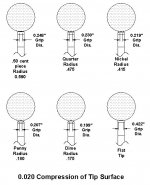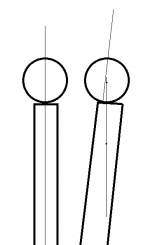Hi Rick,I have one on my break cue. No issues & I use low outside & inside on many of my not head on breaks.
I think it makes perfect sense for those that play trying to hit center CB for most of their shots.
I understand what Colin is saying but I think that what he's talking about might only apply for slight english if one uses an incorrect perception. I think once one get's past say 4 mm of offset it plays normally. At least that seems to be what I get out of mine, but like Dennis Miller, I could be wrong.
I can see where it might play 'mushy' or 'sticky' if done on a soft tip. I did it to my hard break tip only.
Best 2 You & All.
I'm guessing at 4mm offset, the contact point is pretty much where it normally is, between tip and CB, unless the concave section is very large.
A useful thought experiment is a 20mm diameter perfectly flat tip. If one aims to CCB but accidentally misses the aim point on the CB by 10mm, with a 10" (254mm) bridge, the CB will go close to 2.5 degrees from the original alignment. With a rounded tip, bridging within a couple of inches of the effective pivot point, such a stroke error will rarely send the CB more than 0.5 degrees off the original path... and far less if one is familiar with their effective pivot point for such a shot.
imho, it's removing a somewhat serendipitous aspect of shooting accuracy, being the offset direction (pivot) - squirt = near zero, natural cancellation tendency.
Note: Many amateur players play at lower shot speeds and bridge shorter than the effective pivot point for many of their shots. They tend to pivot intuitively such that left pivot moves a CB left of their pre-alignment and vice-versa. They usually pivot to the outside, allowing them to aim thick and swipe to cut, gaining assistance from outside english throw to thin the cut as required.
Probably the main reason amateurs hate power shots is that it eliminates the effectiveness of this peri-stroke adjustment method as their effective pivot point is shortened to nearer their bridge length, and outside throw turning has a lesser effect at higher speeds.
This method of understanding the goings on of pre-alignment and effective alignment via the stroke, take us to the central canard, or cause of misunderstanding in the original video. That misunderstanding is based on the wrong assumption that most potting errors are due to poor stroking, when in fact they are mostly due to poor pre-alignment. I suspect the inventor has suffered the delusion of worrying less about his stroke as a result of his concave tip adjustment and has made improvements in his pre-alignment as a result. For as I've explained already, a concave tip will increase the change of CB angle due to offset striking more significantly in most situations than a normal rounded tip.
Colin
Last edited:

